I left Crowhurst and after crossing a couple of fields arrived at a woodland entrance to the Fore Wood RSPB Nature Reserve.
 The information panel and my guide notes promised a variety of birds and their accompanying birdsong, but I saw or heard neither. It felt odd – I’d seen and heard lots of birds earlier. I wondered if it was too hot for them…….maybe they didn’t perform at midday……..maybe they were having lunch…….maybe they’d just forgotten to unmute!
The information panel and my guide notes promised a variety of birds and their accompanying birdsong, but I saw or heard neither. It felt odd – I’d seen and heard lots of birds earlier. I wondered if it was too hot for them…….maybe they didn’t perform at midday……..maybe they were having lunch…….maybe they’d just forgotten to unmute!
 I continued on the delightful undulating path and exiting the wood, spotted a large Euroforest sign which read “Danger – forestry work – follow all signs and instructions”. I guessed this accounted for the lack of birdsong so resolved to come back again in the spring when my guidenotes also promise rare ferns, bluebells and wood anemones.
I continued on the delightful undulating path and exiting the wood, spotted a large Euroforest sign which read “Danger – forestry work – follow all signs and instructions”. I guessed this accounted for the lack of birdsong so resolved to come back again in the spring when my guidenotes also promise rare ferns, bluebells and wood anemones.
 The trail took me across a couple of fields, one with cattle, through another small wood and across Powdermill Stream. At Peppering Eye Farm I saw a very pretty oast house which had not long been reconstructed complete with its pointed roof and Sussex blinkered cowl.
After crossing the entrance drive to The Powder Mills Hotel the path took me uphill onto the Senlac Hill ridge, the site of the Battle of Hastings. Apparently one doesn’t refer to “the Battle of Hastings” hereabouts….it doesn’t go down too well. Understandable, as Hastings is about 10 km from here. Instead one refers to “the Battle of Senlac Hill”. The town of Battle, just down the hill, was obviously named after the battle but “the Battle of Battle” really wouldn’t have worked!
The trail took me across a couple of fields, one with cattle, through another small wood and across Powdermill Stream. At Peppering Eye Farm I saw a very pretty oast house which had not long been reconstructed complete with its pointed roof and Sussex blinkered cowl.
After crossing the entrance drive to The Powder Mills Hotel the path took me uphill onto the Senlac Hill ridge, the site of the Battle of Hastings. Apparently one doesn’t refer to “the Battle of Hastings” hereabouts….it doesn’t go down too well. Understandable, as Hastings is about 10 km from here. Instead one refers to “the Battle of Senlac Hill”. The town of Battle, just down the hill, was obviously named after the battle but “the Battle of Battle” really wouldn’t have worked!
 Senlac Hill was originally known in English as Santlache meaning “sand lake”, which the Normans punned into Sanguelac “blood lake”, which was then shortened to Senlac. (I picked up such trivia when I was High Sheriff of East Sussex nine years ago!)
After walking through a few more fields by a wooded area the trail led me to the imposing entrance of Battle Abbey, a Grade I listed building and a scheduled monument.
Senlac Hill was originally known in English as Santlache meaning “sand lake”, which the Normans punned into Sanguelac “blood lake”, which was then shortened to Senlac. (I picked up such trivia when I was High Sheriff of East Sussex nine years ago!)
After walking through a few more fields by a wooded area the trail led me to the imposing entrance of Battle Abbey, a Grade I listed building and a scheduled monument.
 William the Conqueror founded Battle Abbey on the exact spot where King Harold died as penance for the bloodshed of the Norman Conquest. The abbey thrived as a Benedictine monastery for over 400 years, and after its suppression in 1538 the abbot’s lodging was transformed into a grand country house which was owned by the Browne family and later the Webster family.
William the Conqueror founded Battle Abbey on the exact spot where King Harold died as penance for the bloodshed of the Norman Conquest. The abbey thrived as a Benedictine monastery for over 400 years, and after its suppression in 1538 the abbot’s lodging was transformed into a grand country house which was owned by the Browne family and later the Webster family.
 Since 1922 part of the Abbey has housed a school. The Government has owned the Abbey since 1976 and it is now in the care of English Heritage.
I crossed the surprisingly busy high street, into the offices of estate agents Batcheller Monkhouse. I was greeted by Wendy Stirk and Rebecca Butler, both Partners of the firm. Batcheller Monkhouse has been a tremendous champion of FSH over the years, having supported many events including several Christmas Fairs, and has hosted two receptions for us here in its Battle office. The office was incredibly busy with a combination of lockdown being lifted and the stamp duty holiday announced by Rishi Sunak last week.
This really was a fabulous walk with varied scenery and points of interest. I will definitely return in the spring!
Since 1922 part of the Abbey has housed a school. The Government has owned the Abbey since 1976 and it is now in the care of English Heritage.
I crossed the surprisingly busy high street, into the offices of estate agents Batcheller Monkhouse. I was greeted by Wendy Stirk and Rebecca Butler, both Partners of the firm. Batcheller Monkhouse has been a tremendous champion of FSH over the years, having supported many events including several Christmas Fairs, and has hosted two receptions for us here in its Battle office. The office was incredibly busy with a combination of lockdown being lifted and the stamp duty holiday announced by Rishi Sunak last week.
This really was a fabulous walk with varied scenery and points of interest. I will definitely return in the spring!
 This section was sponsored by Robert Batcheller and dedicated to the RSPB Nature Reserve at Fore Wood and to the beautiful countryside near Battle where he is so lucky to work and live.
This section was sponsored by Robert Batcheller and dedicated to the RSPB Nature Reserve at Fore Wood and to the beautiful countryside near Battle where he is so lucky to work and live.
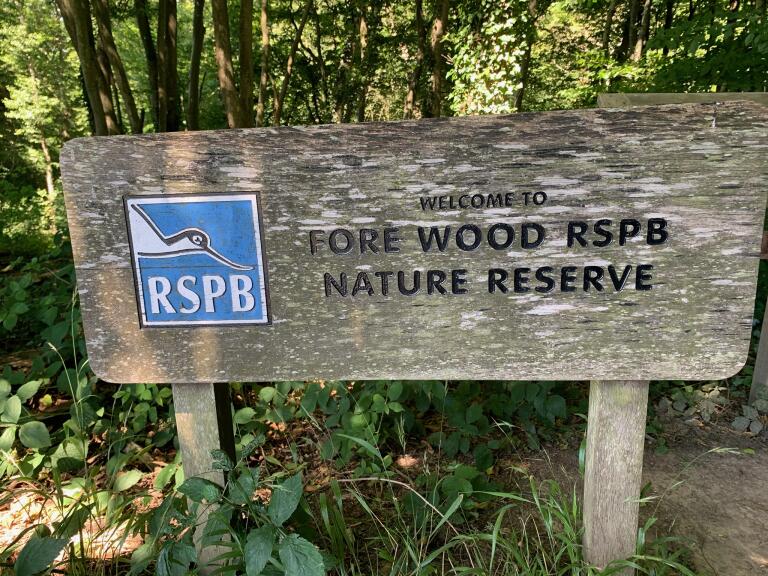 The information panel and my guide notes promised a variety of birds and their accompanying birdsong, but I saw or heard neither. It felt odd – I’d seen and heard lots of birds earlier. I wondered if it was too hot for them…….maybe they didn’t perform at midday……..maybe they were having lunch…….maybe they’d just forgotten to unmute!
The information panel and my guide notes promised a variety of birds and their accompanying birdsong, but I saw or heard neither. It felt odd – I’d seen and heard lots of birds earlier. I wondered if it was too hot for them…….maybe they didn’t perform at midday……..maybe they were having lunch…….maybe they’d just forgotten to unmute!
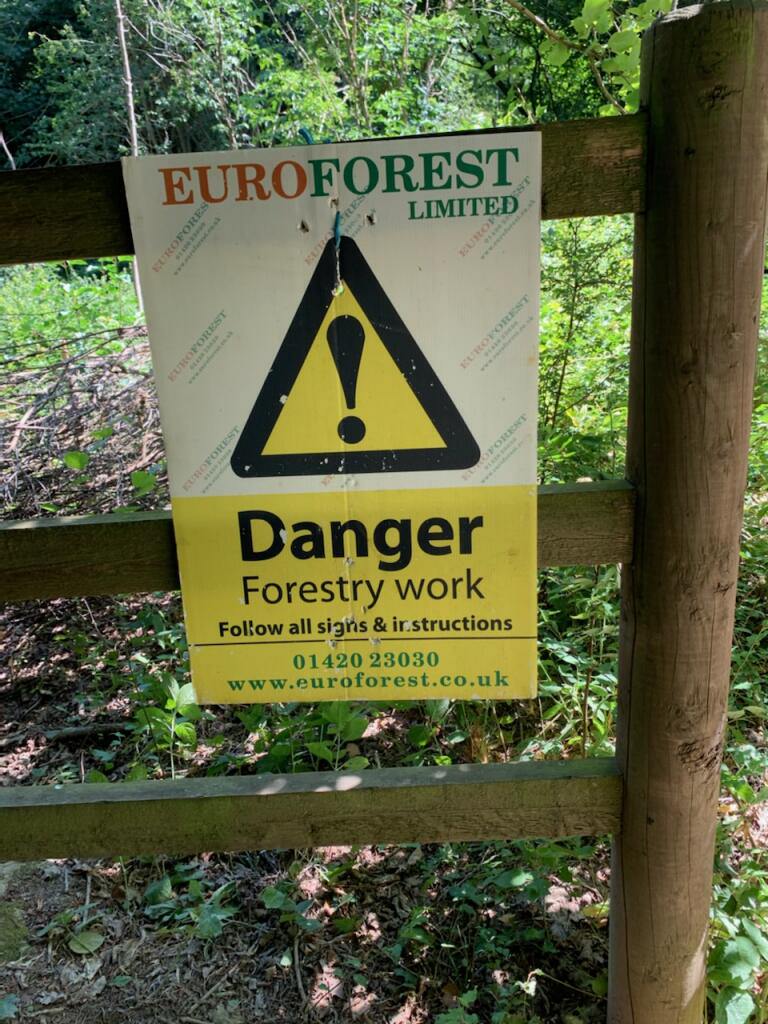 I continued on the delightful undulating path and exiting the wood, spotted a large Euroforest sign which read “Danger – forestry work – follow all signs and instructions”. I guessed this accounted for the lack of birdsong so resolved to come back again in the spring when my guidenotes also promise rare ferns, bluebells and wood anemones.
I continued on the delightful undulating path and exiting the wood, spotted a large Euroforest sign which read “Danger – forestry work – follow all signs and instructions”. I guessed this accounted for the lack of birdsong so resolved to come back again in the spring when my guidenotes also promise rare ferns, bluebells and wood anemones.
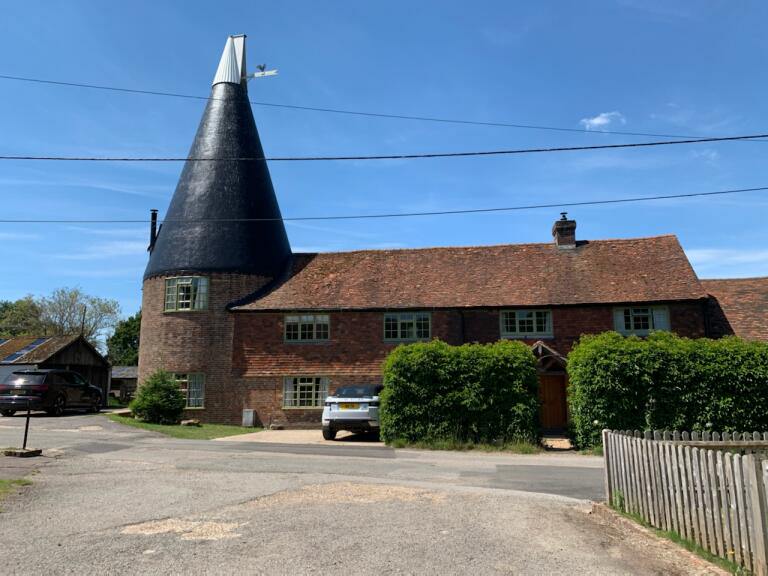 The trail took me across a couple of fields, one with cattle, through another small wood and across Powdermill Stream. At Peppering Eye Farm I saw a very pretty oast house which had not long been reconstructed complete with its pointed roof and Sussex blinkered cowl.
After crossing the entrance drive to The Powder Mills Hotel the path took me uphill onto the Senlac Hill ridge, the site of the Battle of Hastings. Apparently one doesn’t refer to “the Battle of Hastings” hereabouts….it doesn’t go down too well. Understandable, as Hastings is about 10 km from here. Instead one refers to “the Battle of Senlac Hill”. The town of Battle, just down the hill, was obviously named after the battle but “the Battle of Battle” really wouldn’t have worked!
The trail took me across a couple of fields, one with cattle, through another small wood and across Powdermill Stream. At Peppering Eye Farm I saw a very pretty oast house which had not long been reconstructed complete with its pointed roof and Sussex blinkered cowl.
After crossing the entrance drive to The Powder Mills Hotel the path took me uphill onto the Senlac Hill ridge, the site of the Battle of Hastings. Apparently one doesn’t refer to “the Battle of Hastings” hereabouts….it doesn’t go down too well. Understandable, as Hastings is about 10 km from here. Instead one refers to “the Battle of Senlac Hill”. The town of Battle, just down the hill, was obviously named after the battle but “the Battle of Battle” really wouldn’t have worked!
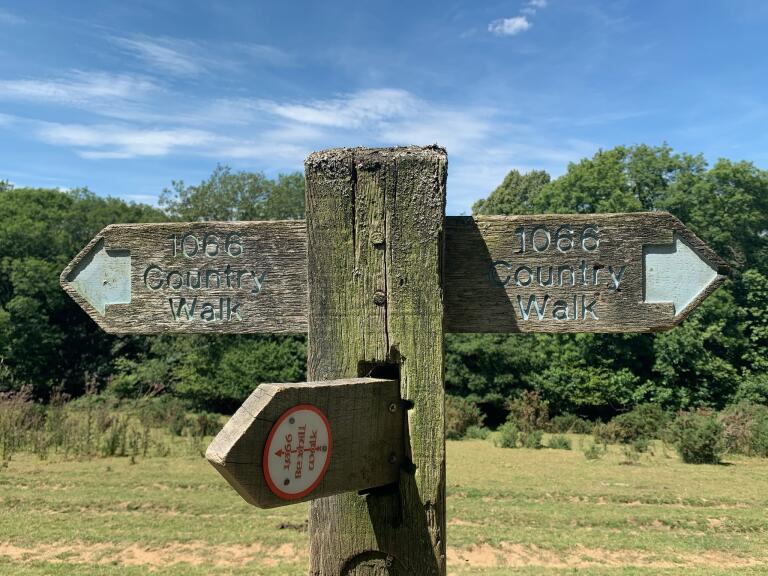 Senlac Hill was originally known in English as Santlache meaning “sand lake”, which the Normans punned into Sanguelac “blood lake”, which was then shortened to Senlac. (I picked up such trivia when I was High Sheriff of East Sussex nine years ago!)
After walking through a few more fields by a wooded area the trail led me to the imposing entrance of Battle Abbey, a Grade I listed building and a scheduled monument.
Senlac Hill was originally known in English as Santlache meaning “sand lake”, which the Normans punned into Sanguelac “blood lake”, which was then shortened to Senlac. (I picked up such trivia when I was High Sheriff of East Sussex nine years ago!)
After walking through a few more fields by a wooded area the trail led me to the imposing entrance of Battle Abbey, a Grade I listed building and a scheduled monument.
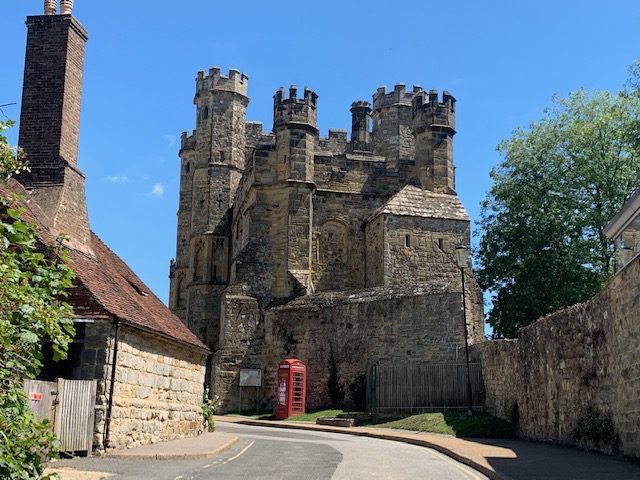 William the Conqueror founded Battle Abbey on the exact spot where King Harold died as penance for the bloodshed of the Norman Conquest. The abbey thrived as a Benedictine monastery for over 400 years, and after its suppression in 1538 the abbot’s lodging was transformed into a grand country house which was owned by the Browne family and later the Webster family.
William the Conqueror founded Battle Abbey on the exact spot where King Harold died as penance for the bloodshed of the Norman Conquest. The abbey thrived as a Benedictine monastery for over 400 years, and after its suppression in 1538 the abbot’s lodging was transformed into a grand country house which was owned by the Browne family and later the Webster family.
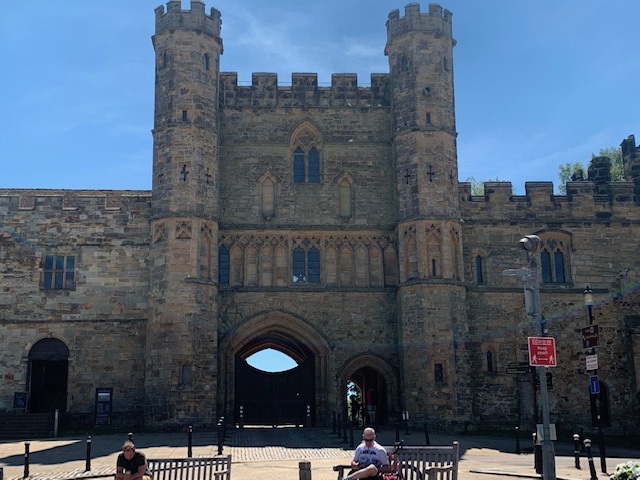 Since 1922 part of the Abbey has housed a school. The Government has owned the Abbey since 1976 and it is now in the care of English Heritage.
I crossed the surprisingly busy high street, into the offices of estate agents Batcheller Monkhouse. I was greeted by Wendy Stirk and Rebecca Butler, both Partners of the firm. Batcheller Monkhouse has been a tremendous champion of FSH over the years, having supported many events including several Christmas Fairs, and has hosted two receptions for us here in its Battle office. The office was incredibly busy with a combination of lockdown being lifted and the stamp duty holiday announced by Rishi Sunak last week.
This really was a fabulous walk with varied scenery and points of interest. I will definitely return in the spring!
Since 1922 part of the Abbey has housed a school. The Government has owned the Abbey since 1976 and it is now in the care of English Heritage.
I crossed the surprisingly busy high street, into the offices of estate agents Batcheller Monkhouse. I was greeted by Wendy Stirk and Rebecca Butler, both Partners of the firm. Batcheller Monkhouse has been a tremendous champion of FSH over the years, having supported many events including several Christmas Fairs, and has hosted two receptions for us here in its Battle office. The office was incredibly busy with a combination of lockdown being lifted and the stamp duty holiday announced by Rishi Sunak last week.
This really was a fabulous walk with varied scenery and points of interest. I will definitely return in the spring!
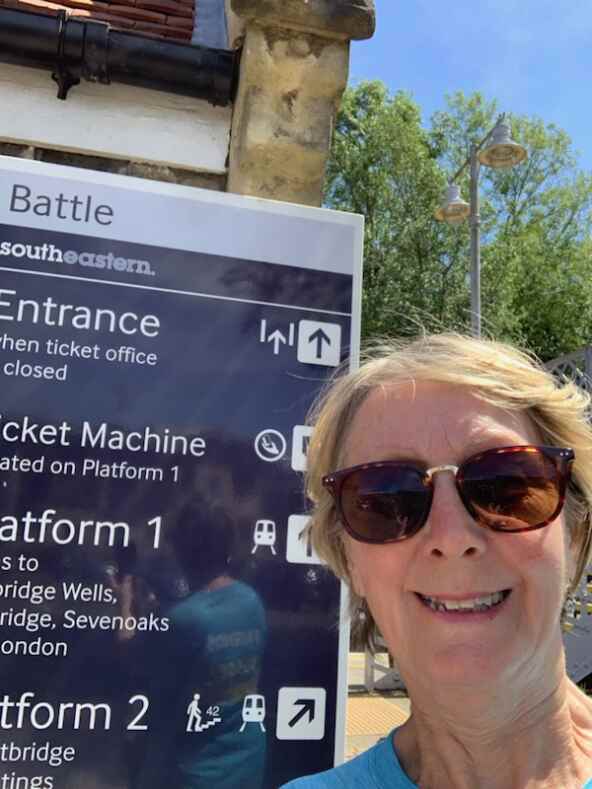 This section was sponsored by Robert Batcheller and dedicated to the RSPB Nature Reserve at Fore Wood and to the beautiful countryside near Battle where he is so lucky to work and live.
This section was sponsored by Robert Batcheller and dedicated to the RSPB Nature Reserve at Fore Wood and to the beautiful countryside near Battle where he is so lucky to work and live. 
